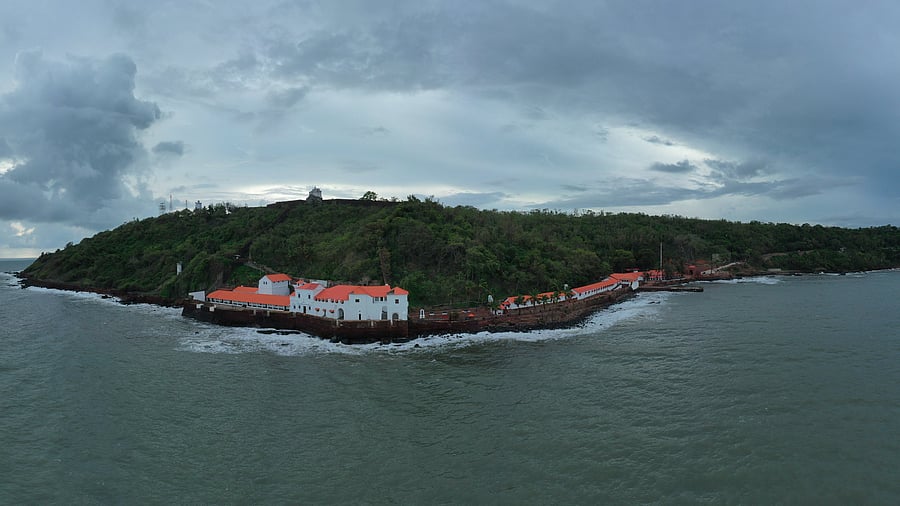
Aguad Jail Complex.
Credit: Gargi Guha
Driving through the hills of Sinquerim village, when I finally arrive at the Aguad Jail Complex, I pause to take in the vista that unfolds before me. A vast panoramic view overlooks the confluence of Mandovi River and the Arabian Sea with milk-white waves lightly crashing ashore punctuating this rather quiet, pleasantly clear day amid what could have been a raging monsoon.
A giant fortress gate is the portal to enter the complex. Upon setting foot inside, the first sight is of the façade, a beautiful red-brown exterior with a statue of Mother India right at the front. The charming white portico extension on the right houses cafés and restaurants, lending a languid holiday vibe.
At a distance of less than 20 km from the capital Panaji, this erstwhile Central Jail and 19th-century lighthouse is of great architectural and historic significance. The fort is named after the Portuguese word, aguada which means water, and used to be a regular port of call for passing ships who stopped for fresh water, supplied by sweet-water springs inside the complex.
This historic address, on the estuary of the Mandovi River has now been transformed and repackaged as a vibrant destination of art and culture. Daily screenings of the Goan Freedom struggle, heritage walks, a lively food and beverage scene and performing arts festivals have helped transform this into one of Goa tourism’s latest showcases.
Constructed in 1612, Aguad served as a defensive stronghold for the Portuguese against the Dutch and Maratha navies. Strategically located near what was referred to as the Bay of Velha (Old Goa) and Nova Goa (Panaji), it served, not only as the nerve centre of prosperous Portuguese trade but also in providing ships with essential replenishment.
In the 1930s, Aguad underwent a significant transformation when Portuguese Prime Minister António de Oliveira Salazar converted it into a place of incarceration for those opposing the regime. This was the veritable dark era of trial and torture.
During the liberation of Goa in 1961, it entered the portal of strife and struggle. The Indian Armed Forces executed Operation Vijay and Operation Chutney, respectively, marking India’s first “integrated” operation.
It was during this historic event that two Indian army personnel sacrificed their lives at the gates of Aguad while attempting to free Goa’s freedom fighters like T B Cunha and Ram Manohar Lohia who had been imprisoned within its walls. Post-liberation, from 1961 to 2015, Aguad served as Goa’s central jail, post which inmates of Aguad were relocated to Colvale Jail.
Today, Aguad stands proudly as a reckoning deeply rooted in Goan identity.
Striking a balance between structural restoration and integrating modern facilities while keeping the authenticity intact, involved strategic planning. And, a generous dose of storytelling.
One of the best ways to experience the innards of the complex, including the serene chapel, a historic freshwater spring, kitchen areas including a big oven for baking bread, and the grim cells of the Aguad jail, is while embarking on a heritage trail.
This one-hour 15-minute traipse through the prison cells up to the gurgling freshwater source and to witness the sheer expanse of the Arabian Sea from the top, was rendered more captivating with a guided narration of this storied address.
The Aguad complex houses a small smattering of restaurants, a tea shop and a jetty bar, which was closed during the time I visited. The longish portico on the right of the entrance has a few good options to stop in for a bite.
Entertainment and music bolster the commercial viability of the cultural centre, so, pop-ups, musical performances, film screenings, and offering the space on rent for discussions and workshops, are being considered.
The Aguad Port and Jail Complex, Goa’s newest museum, uniquely melds the art of digital storytelling with the state’s history and heritage. Operating from the repurposed cells of the historic, centuries-old prison, the Aguad offers a groundbreaking journey through Goa’s history, employing cutting-edge technology, interactive formats and immersive audio-visual media.
Some of the unique interactive installations convey the story of Goa; teleporting visitors to important moments in Goa’s history, with messages from key freedom fighters conveyed through a virtual bottle floating in the sea — a method stranded sailors used to convey messages to the outside world — moving screenings of arts and culture, food, music and folk dances.
The tranquil vibes and rich historical relevance impart significance to the Aguad Jail complex.
For a day unpacking the many layers of Goa, well beyond its beaches, and for tourists looking for a dose of culture, this is where one ought to head.